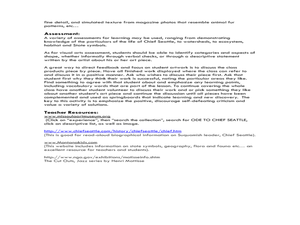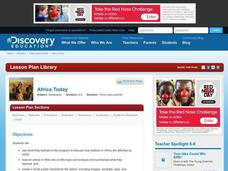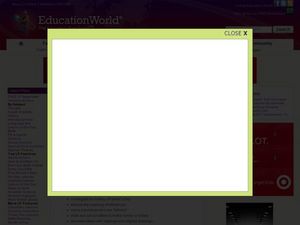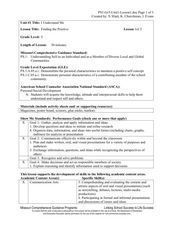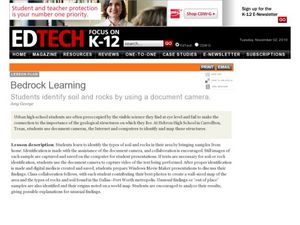Curated OER
From My Point of View
Second graders read a story from an online picture book. After reading the story, they pretend to be Gilbert, one of the main characters and create a narrative to accompany the illustrations. They compare their narrative with that of...
Curated OER
The Role of Geography -- The United States and the Republic of Turkey
Preteens review the five themes of geography. In groups, they examine the United States and Turkey to discover how geography can impact the way people live. They create a foldable for each country, listing information for each of the...
Curated OER
Chairs, Corduroys, Cottages, and Cars: Exploring the Diversity of Design
Students create and present a theme-based exhibition. In this design lesson, students categorize objects to reflect a specific design theme and create their own theme-based collections. Students research a museum collection to discover...
Curated OER
Outdoor Activities/Problem Solving: Home Design
Students create with sticks and stones. For this early childhood lesson plan, students use their problem-solving skills to make houses out of items they find outdoors.
Curated OER
Thank You!
Students demonstrate appreciation for volunteer workers. In this philanthropy lesson, students create a card, picture, or poem for a school volunteer. Students use a variety of art supplies to create the appreciation gift.
Curated OER
What Is Our Plan?
Pupils identify ways to handle pet emergencies. In this animal welfare lesson, students create a list of top ten pet emergency planning tips and checklist. Pupils construct an "Pet Emergency Kit."
Curated OER
Native American Storytelling
Eleventh graders examine the background of Native American myths and legends. In this American History instructional activity, 11th graders read a myth out loud to their classmates. Students compare and contrast their myths...
Curated OER
Map It With Pixie
Fourth graders use the computer program 'Pixie' to create a topographic, detailed map for the state they live in. In this mapping skills lesson, 4th graders use Pixie to make a map of their state that includes topographic features, state...
Curated OER
Color Descriptions
Learners create a book about colors. In this exploring colors lesson plan, students read the book Hailstones and Halibut Bones. Learners select a color and describe how the color looks, feels, tastes, and smells like. Students write down...
Curated OER
Line Symmetry
Fourth graders identify line symmetry. In this geometry instructional activity, 4th graders are given various pictures and identify if they are symmetrical. Students search through magazines for symmetrical pictures.
Curated OER
Identify Nutrient Sources
Students identify the nutrients in food and its functions. In this nutritional needs lesson, students create a chart that identifies the food source, the function of the nutrient, and the effects of a deficiency or excess of the nutrient.
Curated OER
Home Design
Young scholars investigate house structures by examining photographs. In this architecture lesson, students read the book Houses and Homes, analyzing the different structures and materials. Young scholars utilize mud to...
Curated OER
Cut Outs: Shapes and Symbols
Students create collages based on Juan Quick-to-See Smith's "Ode to Chief Seattle." In this shapes, symbols and Native American lesson, students examine the "Ode to Chief Seattle" and Henri Matisse's cutout work. Students design their...
Curated OER
Africa Today
Students examine the AIDS crisis in Africa. In this global studies lesson, students watch "Medical Crisis in Africa," and read articles about AIDS in Africa. Students then research the topic and create awareness posters.
Curated OER
Role Models
Third graders create posters of heroes and present their findings and what they think it means to be a hero. In this role models lesson plan, 3rd graders compare heroes and describe their characteristics.
Curated OER
Collage of Kwanzaa Colors
Students explore African cultures by creating a holiday collage. In this Kwanzaa art lesson, students identify the popular colors associated with the African holiday and create a collage using them. Students present their art work for...
Curated OER
Cupid’s Ambassador: The Cultural Impact of Chocolate
Young scholars review a trip they made to the Hershey Museum. In this history of chocolate lesson, students determine the impact chocolate has made on cultures and create visual projects that feature their findings.
Curated OER
Dad's Magnetic Personality
Students create a gift honoring Father's Day. In this Father's Day lesson, students examine the meaning of fatherhood and explore the history of this tradition. Students create a picture collage over a template of their father's initials.
Curated OER
Canada and the United States: A Collage
Middle schoolers create a visual presentation that describes the influence of American culture on Canadian culture, the Canadian response to that influence, and the benefits and drawbacks of that influence to Canadian culture.
Curated OER
WWI Propaganda
Learners research propaganda from World War I and compare it with propaganda used today. They define propaganda and discuss the five techniques used by advertisers, conduct Internet research, and create a project that compares how...
Curated OER
Stem-and-Leaf Plots
Seventh graders study steam-and-leaf plots. Given specific data, they create a stem-and-leaf plot . Students identify the mean, mode, range and median. Afterward, they review vocabulary words.
Curated OER
Finding the Positive
Fifth graders meet the "Famous Artist." They are introduced to the topic of self-concept. Students work in small groups and get organized to create collages. They create a collage that represents characteristics of positive self-concept.
Curated OER
Tolerance Through My Eyes
Students explore multiculturalism. In this visual arts lesson, students consider how visual arts may provide service opportunities and create artistic pieces inspired by service.
Curated OER
Bedrock Learning
Students test and identify soil and rock samples. In this rock and soil lesson, students video themselves gathering samples. Students test the samples and create graphs showing the results.












